Our peregrine falcon family's history
Since at least 2015, peregrine falcons have made their home at the medical center. Their nest is located a safe distance from the hospital’s busy helipad.
Check out the recaps of the past three seasons as fans watched the peregrine falcon chicks grow and learn.
Livestream: Peregrine falcons return
Watch live2023: Starships Fly Away
In late April 2023, four chicks hatched from their shells in the nest, about a month after the eggs were laid. All four falcon chicks left the nest by the end of June.
The chicks received their official names: Millennium, Serenity, Defiant and Roci. Each was named after a different starship from a television or movie series in space. The names were chosen by Sara Lin from the UC Davis School of Medicine. She won the contest held by UC Davis Health, making the closest guess to when the first peregrine falcon egg would hatch.
A local falcon expert banded the young peregrine falcons for future identification. The bands will provide researchers with valuable data on peregrine survival rates, dispersal distances and population growth rates.


2022: Two Chicks Spread Their Wings
As happened in 2021, the peregrine falcon parents laid four eggs at the end of March. Two of the chicks – both males – emerged from their shells about a month later. Unfortunately, two eggs never hatched.
The fluffy white balls continued to grow as their parents brought them food and protected the nest. Eventually, the youngsters started wandering around the nest area.
A few weeks after they hatched, falcon experts from UC Santa Cruz fitted bands on the young falcons for the second year in a row. The protective falcon parents screeched and dive bombed the researchers as they secured the metal leg bands. The bands provide researchers with valuable data on peregrine survival rates, how far away they travel and population growth rates. This is done with special permission from California Fish and Wildlife.
Eventually, both peregrines spread their wings and few the coop to start their own lives and possibly their own families.

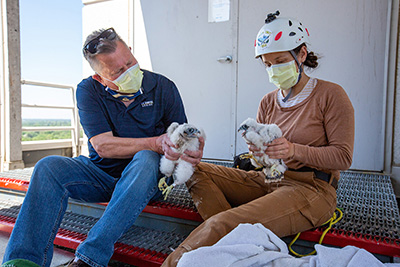
2021: Peregrine falcons ready to fly away
2021: Falcons Participate in UC Santa Cruz Study For First Time
Four peregrine falcons – three females and one male – hatched in mid-April. This year’s nest of peregrines was flight-ready at about six weeks of age.
However, they were clumsy flyers at first. A couple of them fluttered 14 stories down to the ground at the beginning of June and didn’t have the strength to get back to their nesting ledge. Fortunately, helping human hands – and an elevator – returned them to their rightful spot.
A falcon expert from UC Santa Cruz banded the young chicks in early May with the hope of gaining insights into their activities and habitats after they permanently leave the hospital area. One of the parents of the 2021 hatchlings is from a nest on the Rio Vista Bridge. Since that Delta community is part of the region being studied, the medical center’s birds were included in the Bay Area study.
Through July or so, keen observers may could still see and hear the peregrines flying around UC Davis Medical Center and the neighborhoods nearby. The youngsters ventured out fully on their own at the end of July.
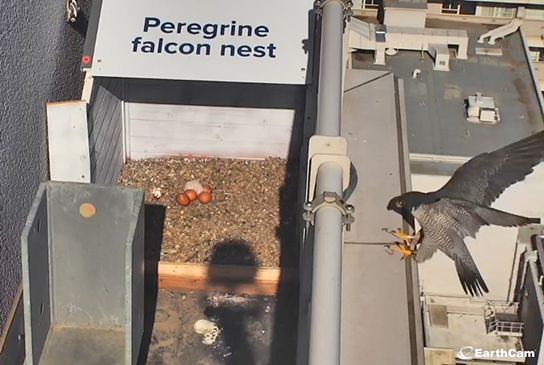
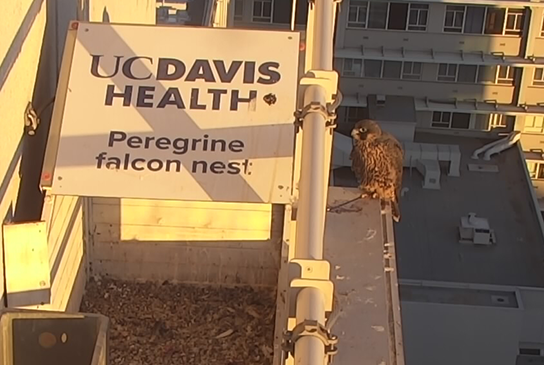
2020: Watching Peanut and His Siblings
For the second year in a row, livestream watchers enjoyed keeping a close eye on the peregrine falcon family as the chicks grew up and left the nest. A record five hatchlings were born in April. The youngest, dubbed “Peanut,” was born five days after the first peregrine chick.
Peanut remained way behind in development, but he showed peregrine viewers that he could work hard to keep up with his bigger siblings. However, as the young falcons began to fly in June, one sibling had to be euthanized after likely flying into a building and couldn't be treated.
Throughout June, the falcon parents were still watching over the kids, providing food while the youngsters learned to hunt on their own. The four remaining fledglings eventually left the nest in early August.
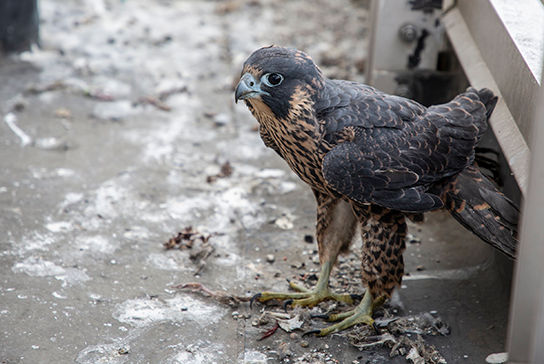
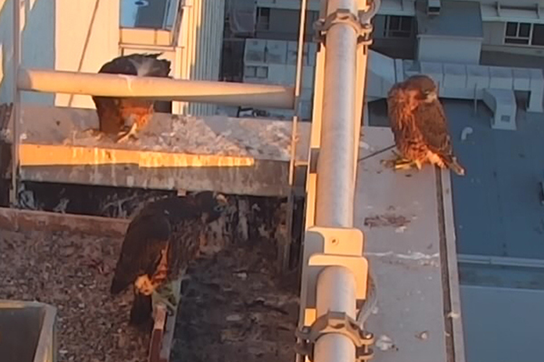
2019: First Year Falcons Were Livestreamed
This year, UC Davis Medical Center enjoyed the successful hatchings of four peregrine chicks, three males and one female, in May 2019.
When the fledglings began trying to fly, one of the youngsters discovered the hard way that she wasn’t quite ready. She was found wandering around the hospital’s loading dock, 14 floors below the nest. She was safely returned her to the nest.
On June 13, another youngster still learning to fly was picked up by Sacramento County Animal Control. It was later released back to its nest by a specialist from Sacramento's Wildlife Care Association.
By August, all four peregrine chicks left the nest and were expected to establish nests in the region.
